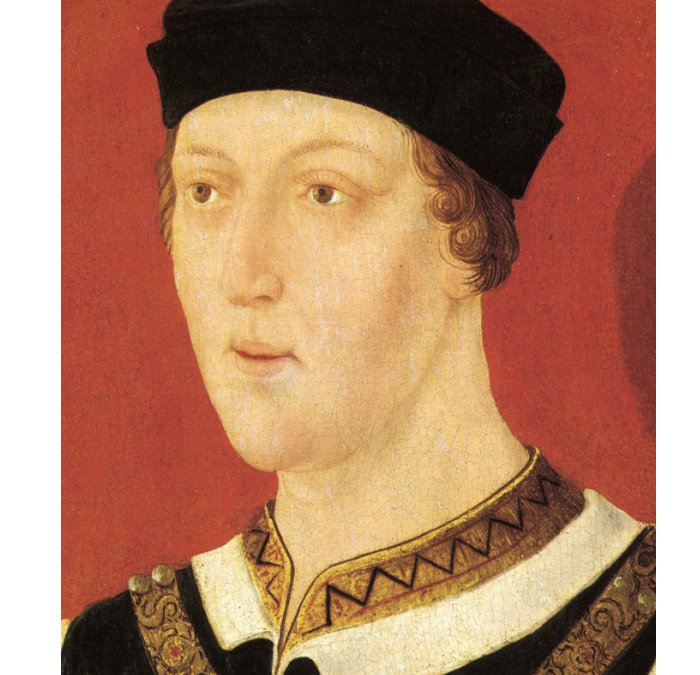Wars Of The Roses: Thirty Two Years Of Struggle To Claim English Throne
A. Sutherland - AncientPages.com - The Wars of the Roses was a civil war in England that lasted from 1455-1487. This thirty-two-year military conflict was fought between the supporters of the House of Lancaster (Lancastrians) and the supporters of the House of York (Yorkists).
Finding Richard's circlet after the battle, Lord Stanley hands it to Henry at the Battle of Bosworth Field, 1485. Engraving, 19th century. Image via Warfare History Network
The name of the wars is related to the roses; a red rose represents the Lancastrians (House of Lancastrians) and the Yorkists by a white rose.
It was a struggle to claim the right to the English throne, and each side sincerely believed they had a rightful claim. The Lancastrians and the Yorkists were two of England's most influential great aristocratic families.
Another important figure in this conflict was an English nobleman, administrator, and military commander, Richard Neville, 16th Earl of Warwick (1428 – 1471). He was wealthy and powerful, with political connections beyond the country's borders.
Neville was initially on the Yorkist side but later switched to the Lancastrian side, and in fact, he was instrumental in the deposition of two kings.
The dispute between the two houses began with the overthrow of King Richard by Henry Bolingbroke, Duke of Lancaster, in 1399. Henry Bolingbroke ( c. April 1367 – 20 March 1413), crowned Henry IV, was King of England from 1399 to 1413, but his rule was widely unpopular. Shortly, a revolt broke out in Wales, Cheshire, and Northumberland, and Henry IV managed to suppress the revolts with difficulty.
He died in 1413, and his successor was Henry V, a popular king and a strong leader who led England against France in the Hundred Years' War (1337 to 1453) and won many battles, giving the Lancastrians enough power to hold on to the throne. When Henry V died in 1422 from dysentery, his son, Henry VI, became his successor as King of England and France, but he had many difficulties in ruling the country. He had a mental illness inherited from his French grandfather, Charles VI.
Henry was an ineffective ruler, surrounded by some unpopular advisors such as Cardinal Beaufort, the Duke of Gloucester, and the Duke of Suffolk When Henry VI's life was about to end, the Yorkists were almost sure their representative would have a right of succession after him.
Henrik VI (1421-1471), Image credi: Anonymous - Public Domain
However, it was not that simple. The new King did not inherit the throne; instead, he was elected. Parliament played an essential role in this challenging political process. It had the enormous power to create a king.
"..Haughty, arrogant kings bowed submissively to its will. Henry could not make laws nor impose taxes without first summoning Parliament and obtaining his subjects' consent. But corrupting influences were at work, which was destined to cheat England out of her liberties for many a year." 1
The country's impoverishment to pay for the war and royal extravagances had awakened a troublesome spirit in the House of Commons. Cruelty to heretics also, and oppressive enactments were fought and defeated in this body. The Kikingclergy, and nobles, were drawing closer together and farther away from the people, and were devising ways of stifling their will…" wrote an American author and historian, Mary Platt Parmele, in her "A Short History of England, Ireland, and Scotland."
At the same time, according to the strict rules of hereditary succession, there were two others with claims superior to Henry's. The Duke of Lancaster, Henry's father (John of Gaunt), was only a younger son of Edward III. Richard Duke of York, his cousin, claimed a double descent from Duke Clarence and the Duke of York, both sons of Edward III.
It is also said that another immediate cause of the York revolt related to Queen Margaret Anjou, who unexpectedly revealed her male child. It had raised serious doubts about the origin of the righteous bed and, of course, seriously contributed to the beginning of the Wars of the Roses, a gloomy and very destructive period in the history of England, where most of the fighting took place, which resulted in significant loss of life and property.
"…Murders, executions, treacheries, adorn a network of intrigue and villainy, … was enough to have made the "White" and the "Red Rose" forever hateful to English eyes."
Many more significant battles and minor clashes occurred between the fighting parts; however, the last and decisive battle military encounter is known as the Battle of Bosworth Field (or Battle of Bosworth).
Henry VII (1457 – 1509), an offshoot of the House of Lancaster), raised a Lancastrian army against Richard III, defeated the Yorkists, and killed Richard at the Battle of Bosworth Field in 1485.
After this battle, the throne of England finally fell to the representative of a strong family - Henry Tudor.
Henry VII was crowned King and married Edward IV's daughter, Princess Elizabeth of York - a move to end the very tiring and devastating period in the history of England - Wars of the Roses. He reunited the two royal houses, merging the rival symbols of the red and white roses into the new emblem of the red and white Tudor rose.
The House of Tudor ruled the Kingdom of England until 1603.
Written by – A. Sutherland AncientPages.com Staff Writer
Updated on October 2, 2022
Copyright © AncientPages.com All rights reserved. This material may not be published, broadcast, rewritten or redistributed in whole or part without the express written permission of AncientPages.com
Expand for referencesReferences:
- Mary Parmele, History of England
More From Ancient Pages
-
 Excavations At Urartu Fortress Will Shed Light On Mysteries Of Ancient Temple
Archaeology | Jul 31, 2019
Excavations At Urartu Fortress Will Shed Light On Mysteries Of Ancient Temple
Archaeology | Jul 31, 2019 -
 Extraordinary Biblical Frescos Uncovered In Domitilla Catacombs
Archaeology | Jun 3, 2017
Extraordinary Biblical Frescos Uncovered In Domitilla Catacombs
Archaeology | Jun 3, 2017 -
 Mysterious Sea People: Many Theories But Their Origin Is still Unknown
Civilizations | Feb 24, 2015
Mysterious Sea People: Many Theories But Their Origin Is still Unknown
Civilizations | Feb 24, 2015 -
 First Cemetery Dated To Roman Period Discovered In North Saqqara, Egypt
Archaeology | Nov 12, 2019
First Cemetery Dated To Roman Period Discovered In North Saqqara, Egypt
Archaeology | Nov 12, 2019 -
 Evidence Of Legendary Ancient Great Flood In China May Re-Write History
Chinese Mythology | Aug 5, 2016
Evidence Of Legendary Ancient Great Flood In China May Re-Write History
Chinese Mythology | Aug 5, 2016 -
 2,000-year-Old Uluburun Shipwreck Reveal Complex Trade Network
Archaeology | Nov 30, 2022
2,000-year-Old Uluburun Shipwreck Reveal Complex Trade Network
Archaeology | Nov 30, 2022 -
 Who Were The Sin Eaters?
Ancient History Facts | Jan 21, 2020
Who Were The Sin Eaters?
Ancient History Facts | Jan 21, 2020 -
 Secret Ancient Knowledge Of Portals Leading To Unknown Realms -The Arrival And Departure – Part 1
Featured Stories | Dec 1, 2021
Secret Ancient Knowledge Of Portals Leading To Unknown Realms -The Arrival And Departure – Part 1
Featured Stories | Dec 1, 2021 -
 Thor And Tyr Journey To Hymir’s Hall To Steal Huge Cauldron – In Norse Mythology
Featured Stories | Jun 6, 2023
Thor And Tyr Journey To Hymir’s Hall To Steal Huge Cauldron – In Norse Mythology
Featured Stories | Jun 6, 2023 -
 Unexpected Discovery Of 600 B.C Assyrian Palace In Shrine Destroyed By Isil Militants
Archaeology | Mar 2, 2017
Unexpected Discovery Of 600 B.C Assyrian Palace In Shrine Destroyed By Isil Militants
Archaeology | Mar 2, 2017 -
 Archery Technology Emerged In The Americas 5,000 Years Ago – Much Earlier Than Previously Thought
Archaeology | Dec 21, 2023
Archery Technology Emerged In The Americas 5,000 Years Ago – Much Earlier Than Previously Thought
Archaeology | Dec 21, 2023 -
 The Real Paleo Diet: New Archaeological Evidence Changes What We Thought About How Ancient Humans Prepared Food
Featured Stories | Nov 28, 2022
The Real Paleo Diet: New Archaeological Evidence Changes What We Thought About How Ancient Humans Prepared Food
Featured Stories | Nov 28, 2022 -
 Script On Gradeshnitsa Tablets May Pre-Date Egyptian Hieroglyphs
Artifacts | Mar 9, 2023
Script On Gradeshnitsa Tablets May Pre-Date Egyptian Hieroglyphs
Artifacts | Mar 9, 2023 -
 Traces Of Viking Raids Remain Visible In Modern Russian Economy And Politics
Archaeology | Feb 9, 2022
Traces Of Viking Raids Remain Visible In Modern Russian Economy And Politics
Archaeology | Feb 9, 2022 -
 Seven Gods Of Happiness – Bring Luck, Prosperity And Health In Japanese Folk Belief
Featured Stories | Jun 29, 2020
Seven Gods Of Happiness – Bring Luck, Prosperity And Health In Japanese Folk Belief
Featured Stories | Jun 29, 2020 -
 Many Roman Citizens Joined The Huns And Preferred Their Nomadic Lifestyle – New Study
Archaeology | Apr 4, 2017
Many Roman Citizens Joined The Huns And Preferred Their Nomadic Lifestyle – New Study
Archaeology | Apr 4, 2017 -
 Pharaoh Hatshepsut: Skillful And Efficient Female Ruler Who Brought Prosperity To Ancient Egypt
Featured Stories | Mar 22, 2017
Pharaoh Hatshepsut: Skillful And Efficient Female Ruler Who Brought Prosperity To Ancient Egypt
Featured Stories | Mar 22, 2017 -
 Dismantled Ancient Stone Circle In West Wales Was Used To Rebuilt As Stonehenge
Archaeology | Feb 13, 2021
Dismantled Ancient Stone Circle In West Wales Was Used To Rebuilt As Stonehenge
Archaeology | Feb 13, 2021 -
 Pre-Hispanic Carved Stone Monuments Discovered On A Mountaintop In Puebla, Mexico
Archaeology | Jul 25, 2020
Pre-Hispanic Carved Stone Monuments Discovered On A Mountaintop In Puebla, Mexico
Archaeology | Jul 25, 2020 -
 Ambition, Greed And Death: The Roman Roots Of ‘Game Of Thrones’
Featured Stories | Jul 2, 2019
Ambition, Greed And Death: The Roman Roots Of ‘Game Of Thrones’
Featured Stories | Jul 2, 2019



